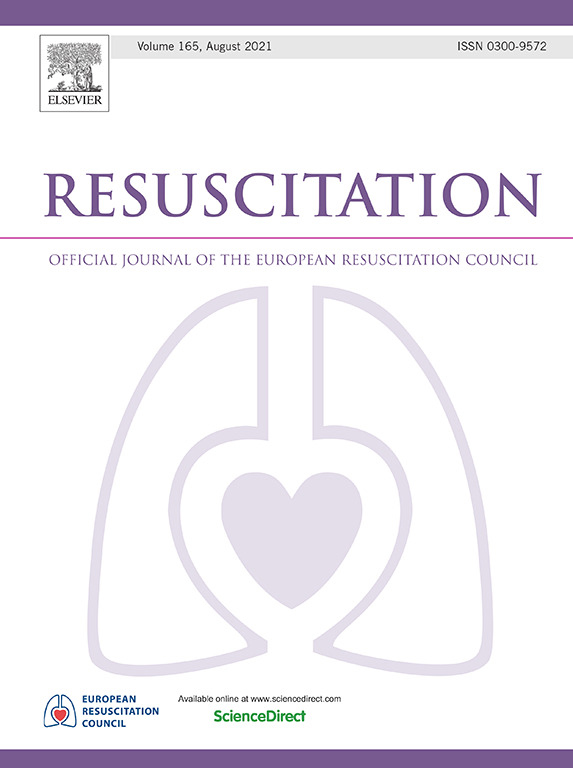用一氧化碳处理心脏骤停心室颤动猪模型的线粒体功能障碍衰减。
IF 6.5
1区 医学
Q1 CRITICAL CARE MEDICINE
引用次数: 0
摘要
背景:院外心脏骤停(OHCA)每年影响美国超过360,000名成年人,死亡率为50-80%。尽管采取了积极的支持性护理和有针对性的体温管理,但仍有一半的成年人活不到出院,近三分之一的幸存者有严重的神经损伤。神经保护疗法的发展对改善预后至关重要。一种很有前途的现成的药剂是一氧化碳(CO)。方法:我们利用猪心室颤动(VF)停搏模型来评估CO对细胞指标的治疗效果。所有动物均行VF骤停后心肺复苏,直至恢复自主循环(ROSC)或20分钟。ROSC后1小时,将动物随机分为心脏骤停组(仅VF)和CO组(VF加CO)。CO组给药200 ppm低剂量CO 2小时。在rosc后3小时,对所有动物实施安乐死,采集组织和血液进行线粒体呼吸(皮质和海马组织)和下游生物分子分析。结果:主要发现是一氧化碳组动物线粒体呼吸和脑内ATP浓度的整体改善。此外,我们还报道了使用无细胞DNA作为生物标志物来定位组织损伤部位和我们的非侵入性光学测量装置来评估脑代谢。结论:一氧化碳可能是一种潜在的治疗骤停后细胞损伤的药物。本文章由计算机程序翻译,如有差异,请以英文原文为准。
Attenuation of mitochondrial dysfunction in a ventricular fibrillation swine model of cardiac arrest treated with carbon monoxide
Background
Out-of-hospital cardiac arrest (OHCA) affects over 360,000 adults in the United States each year with a 50–80% mortality. Despite aggressive supportive care and use of targeted temperature management, half of adults do not live to hospital discharge and nearly one-third of survivors have significant neurologic injury. Development of neuroprotective therapeutics is critical to improving outcomes. One promising readily available agent that has shown benefit is carbon monoxide (CO).
Methods
We utilize a swine model of ventricular fibrillation (VF) arrest to assess the therapeutic effect of CO on cellular measures. All animals underwent VF arrest followed by cardiopulmonary resuscitation until achievement of return of spontaneous circulation (ROSC) or the 20 min mark. One hour following ROSC, animals were randomized to the Cardiac Arrest group (VF alone) versus the CO group (VF treated with CO). Animals in the CO group were administered low dose CO of 200 ppm for two hours. At three hours post-ROSC period, all animals were euthanized for tissue and blood collection for mitochondrial respiration (cortical and hippocampal tissue) and the downstream biomolecular analysis.
Results
The primary findings were an overall improvement in mitochondrial respiration and ATP concentrations in the brain from animals in the CO group. In addition, we also report the use of cell-free DNA as a biomarker to localize the site of tissue injury and our non-invasive optical monitoring device to assess cerebral metabolism.
Conclusions
CO may be a potential therapeutic to attenuate cellular injury in post-arrest.
求助全文
通过发布文献求助,成功后即可免费获取论文全文。
去求助
来源期刊

Resuscitation
医学-急救医学
CiteScore
12.00
自引率
18.50%
发文量
556
审稿时长
21 days
期刊介绍:
Resuscitation is a monthly international and interdisciplinary medical journal. The papers published deal with the aetiology, pathophysiology and prevention of cardiac arrest, resuscitation training, clinical resuscitation, and experimental resuscitation research, although papers relating to animal studies will be published only if they are of exceptional interest and related directly to clinical cardiopulmonary resuscitation. Papers relating to trauma are published occasionally but the majority of these concern traumatic cardiac arrest.
 求助内容:
求助内容: 应助结果提醒方式:
应助结果提醒方式:


